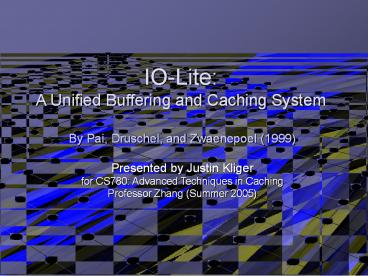IO-Lite: A Unified Buffering and Caching System - PowerPoint PPT Presentation
Title:
IO-Lite: A Unified Buffering and Caching System
Description:
The I/O subsystem and various applications all tend to use their own ... To make up for immutable buffers: Create buffer aggregate abstraction (an ADT) mutable ... – PowerPoint PPT presentation
Number of Views:357
Avg rating:3.0/5.0
Title: IO-Lite: A Unified Buffering and Caching System
1
IO-LiteA Unified Buffering and Caching System
- By Pai, Druschel, and Zwaenepoel (1999)
- Presented by Justin Kliger
- for CS780 Advanced Techniques in Caching
- Professor Zhang (Summer 2005)
2
Outline
- Problem Significance
- Literature Review
- Proposed Solution
- Design, Implementation, Operation
- Experimental Design
- Results
- Conclusion
- Further Research
3
The Problem
- The I/O subsystem and various applications all
tend to use their own private I/O buffers - Redundant data copying
- Multiple buffering
- Lack of cross-subsystem optimization
4
Problems Significance
- Wastes memory
- Reduces space
- available for caching
- Causes higher cache
- miss rates
- High CPU overhead
- Limits server throughput
5
Literature Review
- POSIX I/O
- -Problem
- double-buffering
- Memory-mapped files (mmap)
- -Problem
- Not generalized to network I/O
6
Literature Review
- Transparent Copy Avoidance
- -Problem
- VM page alignment problems
- Copy-on-write faults
- Genie (emulated copy)
- Lack of full transparency leads to same problems
- Copy Avoidance with Handoff Semantics
- -Problem
- Lack of concurrent sharing reduces effectiveness
7
Literature Review
- Fast buffers (fbufs)
- Designed by Druschel
- -Problem
- Does not support filesystem access,
- or a file cache
- Extensible kernels
- -Problem
- More overhead, not OS-portable
8
IO-Lite Solution
- Unified buffering and caching
- Allow all applications and subsystems share the
same buffered I/O data - Very simple at face value,
- very complex to implement
9
Basic Design
- Immutable buffers
- Initial allocated data cannot be modified
- Effectively read-only sharing
- Advantages?
- Eliminates synchronization and protection
problems - Disadvantages?
- I/O data cannot be modified in place
10
Further Design Considerations
- To make up for immutable buffers
- Create buffer aggregate abstraction (an ADT)
- mutable
- Reference to IO-Lite Window in VM
- Aggregates contain ordered list of form ltaddress,
lengthgt - Aggregates passed by value
- Buffers passed by reference
11
Further Design Considerations
- Buffer sharing must be concurrent
- To achieve this, use similar method to fbufs
- Expand to include the filesystem
- Adapts for general purpose OS
- Worst case scenario (in terms of overhead)
- Page remapping
- (when last buffer is allocated before first is
deallocated)
12
IO-Lite Implementation
- New read write API which supersedes the
regular read write - size_t IOL_read(int fd, IOL_Agg aggr, size_t
size) - size_t IOL_write(int fd, IOL_Agg aggr)
- IOL_Agg is buffer aggregate data type
- Both operations are atomic
13
IO-Lite Implementation
- Applications
- Recommends implementation in runtime I/O
Libraries to avoid modifying all programs - Filesystem
- File cache data structure ltfile-id, offset,
lengthgt - Network
- Need to modify network device drivers to allow
early demultiplexing (using a packet filter)
14
IO-Lite Operation
- With regards to the cache
- Cache replacement basically LRU
- Allows for application customization
- Cache eviction controlled by VM daemon
- Do gt½ replaced pages contain I/O data?
15
IO-Lite Operation
- Impact of immutable buffers
- Case 1 Entire object is modified
- Lack of in-place modification has no ill effect
- Case 2 Subset of object needs to be modified
- Rather than recopy entire object, use chaining
- Performance loss is small if blocks are
localized - Case 3 Scattered subset needs modification
- IO-Lite incorporates mmap interface for this
16
Experimental Design
- Compared
- Apache 1.3.1
- Widely used web server
- Flash (event-driven HTTP server)
- Designed by authors in previous year
- Flash-Lite (Flash modified to use IO-Lite API)
- New design by authors
17
Experimental Design
- General varied requested file size
- 40 requests for same file
- File size ranged from 500 bytes 200 Kbytes
- Persistent connections
- Reduces overhead
- CGI
- Additional I/O traditionally slows servers
18
Experimental Design
- Real workloads
- Shows performance benefits by allowing more space
for caching - Based on Rices CSCI department logs
- Wide Area Network (WAN)
- Test throughput with 0-256 slow clients
connecting - Applications
- Incorporated API into UNIX programs
19
Results
- General test
- Bandwidth increase of 43 over Flash, 137 over
Apache - No real difference for files less than 5KBytes
20
Results
- Persistent Connections
- Flash-Lite even more effective at smaller file
sizes - CGI
- All servers slow, but Flash-Lite still much
better - Real workload
- Flash-Lite throughput 65 greater than Apache
- WAN
- Flash-Lite does not suffer from slow clients
- Applications
- Varied improvement for all programs tested
21
Conclusion
- IO-Lite consistently improved performance in all
contexts tested - Requires modification to numerous libraries and
network device drivers - EG see Peng, Sharma, Chiueh (2003)
22
Further Research
- There have been 42 citations
- Almost all fell between 2001-2003
- Authors have not written any follow-ups
- Lack of papers that involve implementation of
IO-Lite or a variation of it - Probably because of complexity and number of
modifications that are necessary
23
Appendix Figures
2) 4) 5)
3)
6)
24
Questions?































